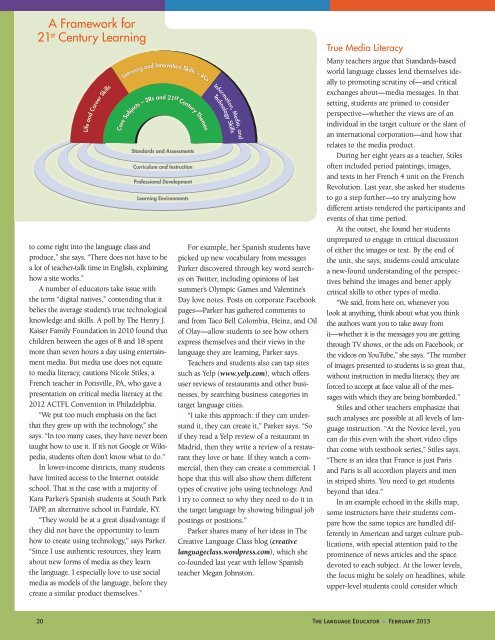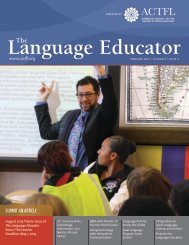Create successful ePaper yourself
Turn your PDF publications into a flip-book with our unique Google optimized e-Paper software.
A Framework for<br />
21 st Century Learning<br />
to come right into the language class and<br />
produce,” she says. “There does not have to be<br />
a lot of teacher-talk time in English, explaining<br />
how a site works.”<br />
A number of educators take issue with<br />
the term “digital natives,” contending that it<br />
belies the average student’s true technological<br />
knowledge and skills. A poll by The Henry J.<br />
Kaiser Family Foundation in 2010 found that<br />
children between the ages of 8 and 18 spent<br />
more than seven hours a day using entertainment<br />
media. But media use does not equate<br />
to media literacy, cautions Nicole Stiles, a<br />
French teacher in Pottsville, PA, who gave a<br />
presentation on critical media literacy at the<br />
2012 ACTFL Convention in Philadelphia.<br />
“We put too much emphasis on the fact<br />
that they grew up with the technology,” she<br />
says. “In too many cases, they have never been<br />
taught how to use it. If it’s not Google or Wikipedia,<br />
students often don’t know what to do.”<br />
In lower-income districts, many students<br />
have limited access to the Internet outside<br />
school. That is the case with a majority of<br />
Kara Parker’s Spanish students at South Park<br />
TAPP, an alternative school in Fairdale, KY.<br />
“They would be at a great disadvantage if<br />
they did not have the opportunity to learn<br />
how to create using technology,” says Parker.<br />
“Since I use authentic resources, they learn<br />
about new forms of media as they learn<br />
the language. I especially love to use social<br />
media as models of the language, before they<br />
create a similar product themselves.”<br />
20<br />
Life and Career Skills<br />
Learning and Innovation Skills – 4Cs<br />
Core Subjects – 3Rs and 21st Century Themes<br />
Standards and Assessments<br />
Curriculum and Instruction<br />
Professional Development<br />
Learning Environments<br />
Information, Media, and<br />
Technology Skills<br />
For example, her Spanish students have<br />
picked up new vocabulary from messages<br />
Parker discovered through key word searches<br />
on Twitter, including opinions of last<br />
summer’s Olympic Games and Valentine’s<br />
Day love notes. Posts on corporate Facebook<br />
pages—Parker has gathered comments to<br />
and from Taco Bell Colombia, Heinz, and Oil<br />
of Olay—allow students to see how others<br />
express themselves and their views in the<br />
language they are learning, Parker says.<br />
Teachers and students also can tap sites<br />
such as Yelp (www.yelp.com), which offers<br />
user reviews of restaurants and other businesses,<br />
by searching business categories in<br />
target language cities.<br />
“I take this approach: if they can understand<br />
it, they can create it,” Parker says. “So<br />
if they read a Yelp review of a restaurant in<br />
Madrid, then they write a review of a restaurant<br />
they love or hate. If they watch a commercial,<br />
then they can create a commercial. I<br />
hope that this will also show them different<br />
types of creative jobs using technology. And<br />
I try to connect to why they need to do it in<br />
the target language by showing bilingual job<br />
postings or positions.”<br />
Parker shares many of her ideas in The<br />
Creative Language Class blog (creative<br />
languageclass.wordpress.com), which she<br />
co-founded last year with fellow Spanish<br />
teacher Megan Johnston.<br />
True Media Literacy<br />
Many teachers argue that Standards-based<br />
world language classes lend themselves ideally<br />
to promoting scrutiny of—and critical<br />
exchanges about—media messages. In that<br />
setting, students are primed to consider<br />
perspective—whether the views are of an<br />
individual in the target culture or the slant of<br />
an international corporation—and how that<br />
relates to the media product.<br />
During her eight years as a teacher, Stiles<br />
often included period paintings, images,<br />
and texts in her French 4 unit on the French<br />
Revolution. Last year, she asked her students<br />
to go a step further—to try analyzing how<br />
different artists rendered the participants and<br />
events of that time period.<br />
At the outset, she found her students<br />
unprepared to engage in critical discussion<br />
of either the images or text. By the end of<br />
the unit, she says, students could articulate<br />
a new-found understanding of the perspectives<br />
behind the images and better apply<br />
critical skills to other types of media.<br />
“We said, from here on, whenever you<br />
look at anything, think about what you think<br />
the authors want you to take away from<br />
it—whether it is the messages you are getting<br />
through TV shows, or the ads on Facebook, or<br />
the videos on YouTube,” she says. “The number<br />
of images presented to students is so great that,<br />
without instruction in media literacy, they are<br />
forced to accept at face value all of the messages<br />
with which they are being bombarded.”<br />
Stiles and other teachers emphasize that<br />
such analyses are possible at all levels of language<br />
instruction. “At the Novice level, you<br />
can do this even with the short video clips<br />
that come with textbook series,” Stiles says.<br />
“There is an idea that France is just Paris<br />
and Paris is all accordion players and men<br />
in striped shirts. You need to get students<br />
beyond that idea.”<br />
In an example echoed in the skills map,<br />
some instructors have their students compare<br />
how the same topics are handled differently<br />
in American and target culture publications,<br />
with special attention paid to the<br />
prominence of news articles and the space<br />
devoted to each subject. At the lower levels,<br />
the focus might be solely on headlines, while<br />
upper-level students could consider which<br />
The Language Educator n February 2013



